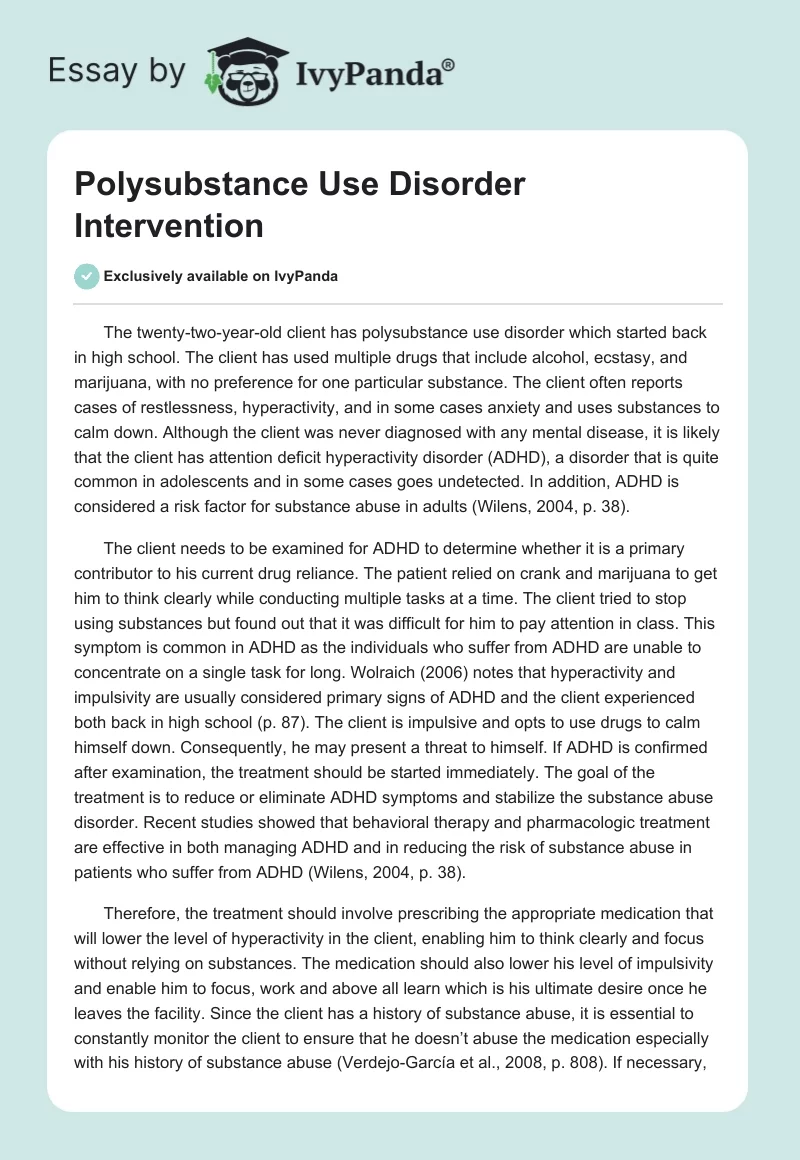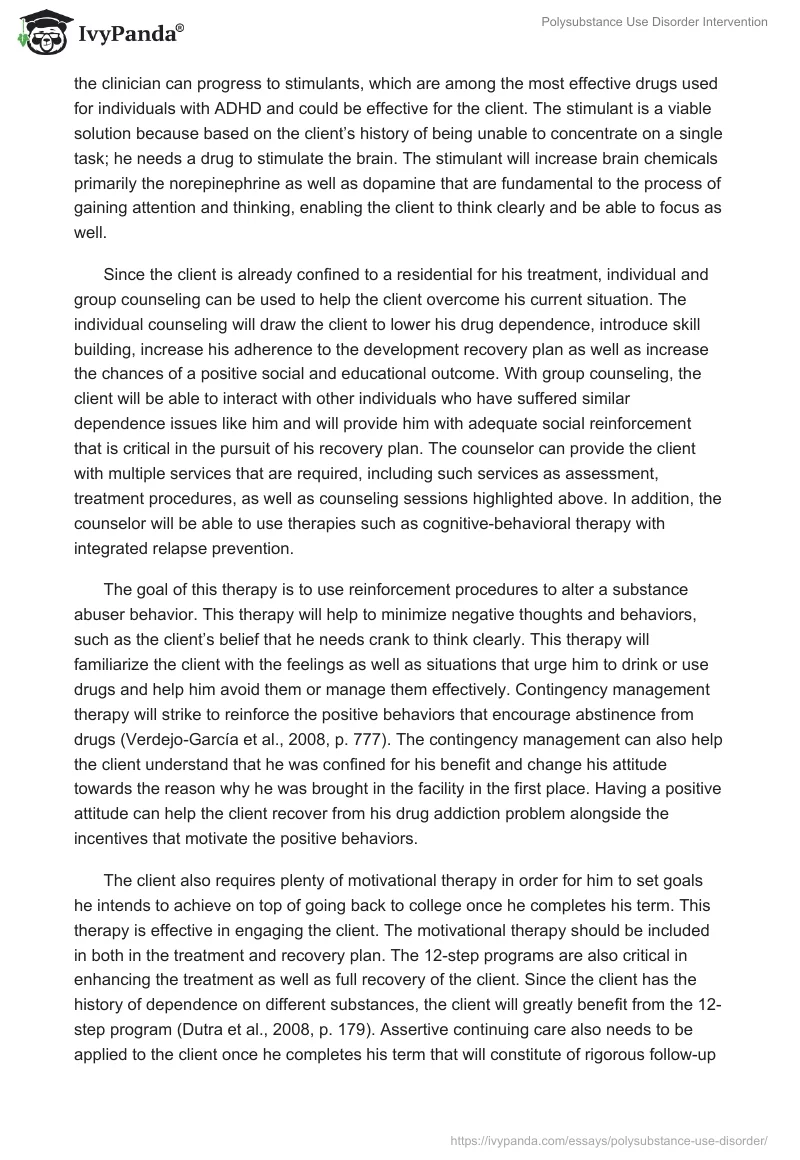The twenty-two-year-old client has polysubstance use disorder which started back in high school. The client has used multiple drugs that include alcohol, ecstasy, and marijuana, with no preference for one particular substance. The client often reports cases of restlessness, hyperactivity, and in some cases anxiety and uses substances to calm down. Although the client was never diagnosed with any mental disease, it is likely that the client has attention deficit hyperactivity disorder (ADHD), a disorder that is quite common in adolescents and in some cases goes undetected. In addition, ADHD is considered a risk factor for substance abuse in adults (Wilens, 2004, p. 38).
The client needs to be examined for ADHD to determine whether it is a primary contributor to his current drug reliance. The patient relied on crank and marijuana to get him to think clearly while conducting multiple tasks at a time. The client tried to stop using substances but found out that it was difficult for him to pay attention in class. This symptom is common in ADHD as the individuals who suffer from ADHD are unable to concentrate on a single task for long. Wolraich (2006) notes that hyperactivity and impulsivity are usually considered primary signs of ADHD and the client experienced both back in high school (p. 87). The client is impulsive and opts to use drugs to calm himself down. Consequently, he may present a threat to himself. If ADHD is confirmed after examination, the treatment should be started immediately. The goal of the treatment is to reduce or eliminate ADHD symptoms and stabilize the substance abuse disorder. Recent studies showed that behavioral therapy and pharmacologic treatment are effective in both managing ADHD and in reducing the risk of substance abuse in patients who suffer from ADHD (Wilens, 2004, p. 38).
Therefore, the treatment should involve prescribing the appropriate medication that will lower the level of hyperactivity in the client, enabling him to think clearly and focus without relying on substances. The medication should also lower his level of impulsivity and enable him to focus, work and above all learn which is his ultimate desire once he leaves the facility. Since the client has a history of substance abuse, it is essential to constantly monitor the client to ensure that he doesn’t abuse the medication especially with his history of substance abuse (Verdejo-García et al., 2008, p. 808). If necessary, the clinician can progress to stimulants, which are among the most effective drugs used for individuals with ADHD and could be effective for the client. The stimulant is a viable solution because based on the client’s history of being unable to concentrate on a single task; he needs a drug to stimulate the brain. The stimulant will increase brain chemicals primarily the norepinephrine as well as dopamine that are fundamental to the process of gaining attention and thinking, enabling the client to think clearly and be able to focus as well.
Since the client is already confined to a residential for his treatment, individual and group counseling can be used to help the client overcome his current situation. The individual counseling will draw the client to lower his drug dependence, introduce skill building, increase his adherence to the development recovery plan as well as increase the chances of a positive social and educational outcome. With group counseling, the client will be able to interact with other individuals who have suffered similar dependence issues like him and will provide him with adequate social reinforcement that is critical in the pursuit of his recovery plan. The counselor can provide the client with multiple services that are required, including such services as assessment, treatment procedures, as well as counseling sessions highlighted above. In addition, the counselor will be able to use therapies such as cognitive-behavioral therapy with integrated relapse prevention.
The goal of this therapy is to use reinforcement procedures to alter a substance abuser behavior. This therapy will help to minimize negative thoughts and behaviors, such as the client’s belief that he needs crank to think clearly. This therapy will familiarize the client with the feelings as well as situations that urge him to drink or use drugs and help him avoid them or manage them effectively. Contingency management therapy will strike to reinforce the positive behaviors that encourage abstinence from drugs (Verdejo-García et al., 2008, p. 777). The contingency management can also help the client understand that he was confined for his benefit and change his attitude towards the reason why he was brought in the facility in the first place. Having a positive attitude can help the client recover from his drug addiction problem alongside the incentives that motivate the positive behaviors.
The client also requires plenty of motivational therapy in order for him to set goals he intends to achieve on top of going back to college once he completes his term. This therapy is effective in engaging the client. The motivational therapy should be included in both in the treatment and recovery plan. The 12-step programs are also critical in enhancing the treatment as well as full recovery of the client. Since the client has the history of dependence on different substances, the client will greatly benefit from the 12-step program (Dutra et al., 2008, p. 179). Assertive continuing care also needs to be applied to the client once he completes his term that will constitute of rigorous follow-up procedures designed to prevent the relapse once he is discharged and should be conducted by a group of professionals.
Since the client bears ADHD symptoms from his childhood that are still dominant in is adulthood and have likely contributed to his addiction problem, it is critical to refer the client to a medical specialist who deals with ADHD mental disorders. This specialist will be able to examine the behavioral patterns of the client and conduct other examinations to conclude whether the client has ADHD that went undetected. The specialist will then provide the best medication for the client and if necessary, the stimulants that will be effective for the client’s condition. Once the client completes his treatment successfully including pharmacologic treatment and behavioral therapy, he can be released back to the community. The referral, in this case, will have been successful, and once the client is released back to the community, the chances of a relapse will be minimal. The chances of a relapse taking place depend on the success of the referral as a successful referral means that the client’s problem is eliminated entirely, eradicating the chances of a relapse taking place. Therefore, relapse potential depends on whether the referral process was successful and whether the referral specialist was able to fully address the problem from its cause roots.
References
Dutra, L., Stathopoulou, G., Basden, S. L., Leyro, T. M., Powers, M. B., & Otto, M. W. (2008). A meta-analytic review of psychosocial interventions for substance use disorders. American Journal of Psychiatry, 165(2), 179-187. Web.
Verdejo-García, A., Lawrence, A. J., & Clark, L. (2008). Impulsivity as a vulnerability marker for substance-use disorders: review of findings from high-risk research, problem gamblers and genetic association studies. Neuroscience & Biobehavioral Reviews, 32(4), 777-810.
Wilens, T. (2004). Impact of ADHD and Its Treatment on Substance Abuse in Adults. Journal of Clinical Psychiatry, 65, 38-45. Web.
Wolraich, M. (2006). Attention-Deficit/Hyperactivity Disorder.Infants & Young Children, 19(2), 86-93. Web.


